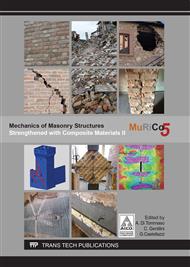[1]
A. Napoli, and R. Realfonzo, Sistemi SFRP e SFRG per il rinforzo di elementi in calcestruzzo: risultati di test di delaminazione, Proc. of "XX Congresso CTE, Milano, November 6-8: 21-30 [in Italian]. (2014).
Google Scholar
[2]
R. Realfonzo, A. Napoli, F. Ascione, & M. Lamberti, Bond behavior of SRP/SRG systems on concrete substrate: experimental investigation, The New Boundaries of Structural Concrete - Proc. of the Fourth Intern. Workshop, NBSC'16, Capri, 29 Sep-1 Oct, 10 pp. (2016).
DOI: 10.1016/j.compstruct.2017.08.063
Google Scholar
[3]
AC434-ICC-Evaluation Service, Acceptance Criteria for Masonry and Concrete Strengthening using Fabric-Reinforced Cementitious Matrix (FRCM) Composite Systems. Whittier, CA. (2013).
DOI: 10.14359/51702356
Google Scholar
[4]
S. Scheerer, F. Schladitz, and M. Curbach, Textile reinforced concrete – from the idea to a high performance material, Bagneux: RILEM. FERRO-11 Proc., 11th International Symposium and 3rd ICTRC International Conference on Textile Reinforced Concrete, Aachen, Germany 7-10 June 2015, (Brameshuber, W. (Ed. ), 15-34.
DOI: 10.1617/2351580087.022
Google Scholar
[5]
W. Brameshuber, RILEM TC 232-TDT: Recommendation of RILEM TC 232-TDT: Test Methods and Design of Textile Reinforced Concrete. Uniaxial Tensile Test: Test Method to Determine the Load Bearing Behavior of Tensile Specimens Made of Textile Reinforced Concrete, Materials and Structures, RILEM 49, Nr. 12, 4923-4927. (2016).
DOI: 10.1617/s11527-016-0839-z
Google Scholar
[6]
C. Carloni , S. Verre, L.H. Sneed, and L. Ombres, Loading rate effect on the debonding phenomenon in fiber reinforced cementitious matrix-concrete joints, Compos. Part B, 108, 301-314. (2017).
DOI: 10.1016/j.compositesb.2016.09.087
Google Scholar
[7]
G. De Felice, M. A. Aiello, A. Bellini, F. Ceroni, S. De Santis, E. Garbin, M. Leone, G. P. Lignola, M. Malena, C. Mazzotti, M. Panizza, M. R. Valluzzi, Experimental characterization of composite-to-brick masonry shear bond, Mater. Struct., 49, 2581–2596. (2016).
DOI: 10.1617/s11527-015-0669-4
Google Scholar
[8]
S. De Santis, G. de Felice, Steel reinforced grout for the strengthening of masonry structures, Compos. Struct., 134, 533-548. (2015).
DOI: 10.1016/j.compstruct.2015.08.094
Google Scholar
[9]
J. Donnini, V. Corinaldesi and A. Nanni, Mechanical properties of FRCM using carbon fabrics with different coating treatments, Compos. Part B, 88, 220-228. (2016).
DOI: 10.1016/j.compositesb.2015.11.012
Google Scholar


